The Development of
the Educational Structure of Prague
One of the main research aims in the field of urban geography is the evaluation of spatial
structure of the city. Results of population censuses make possible to evaluate regularly
changes in a distribution of both the physical and the social space of the city. Important
but till now not very often applied indicator of social status of the city parts is the
educational level of population. Our study is focused on the general features of development
of the education in Prague and in the CR, the evaluation of population distribution according
to the achieved level if education in Prague and the reasons of changes in this distribution
in period 1980 - 1991. This paper is based on data taken from the population census in capital
city of Prague, esp. on unpublished data concerning education of population that Czech
Statistical Office provided to Chief Architect's Office.
According to the population census in 1991 in Prague permanently live 1 214 174 inhabitants.
In this year almost one million Prague's citizens was in the age above fifteen years and they
were asked to fill in a type of their attained education. The different types of schools were
divided into four basic categories as is shown in the figures 1 and 2. We can compare the
proportion of each category in total population of Prague and the Czech Republic in the period
1970 - 1991.
Figures shows a trend of increasing number of the population with higher types of education
in the city as well as in the whole republic. We can also compare the structure of the
population in Prague and in the Czech Republic in periods of particular censuses. Prague is
traditional centre of education, science and research that requires a large number of qualified
experts. Significant differences are especially in the proportion of the population with higher
types of education. Comparing the proportion of the Prague's population in relevant categories
(the Czech Republic = 100 % - see Figure 3), we find out a gradual fall of the weight of Prague
in all categories of education. An interesting fact is seen in the case of secondary and higher
education when on the one hand we can find out increasing number and percentage of these
categories in population of Prague and on the other hand decreasing percentage of Prague's
citizens with secondary and higher education in the Czech Republic. Nevertheless, in the capital
there is still concentrated more than one fourth of graduated people of CR (and for example
47 % of all graduated people with economic orientation).
The educational level of population depends on various factors. Among the most important factors
belong basic demographic features, especially age and sex structure. Although the differences
in the educational level among males and females have diminished, nevertheless the lower level
of education of females is still an important feature of our society. Significant differences
are obvious especially in the proportion of people with higher and primary education
(see Tab. 1).
| Type of education | ife 1970 | ife 1991 |
| primary | 224,9 | 190,7 |
| apprentice | 82,4 | 95,6 |
| secondary | 105,8 | 144,6 |
| university | 40,6 | 62,5 |
Tab. 1 - Feminity index (proportion of females per 100 males) in
particular categories of education in Prague in 1970 and 1991.
Source: Population census 1970 and 1991, Ouředníček (1995).
Important influence on the educational level of society has the age structure.
The younger population the higher attained level of education. The proportion of young
people with secondary or higher education is growing up. At the same time the process
of dying of the oldest generation is occurred. In this age category there is a large
proportion of people without any education or with the primary one (it was for example 66 %
of females above sixty years in 1991).
| age | primary education (%) | university education (%) |
| 25-29 | 6,9 | 22,5 |
| 30-34 | 7,8 | 26,3 |
| 35-39 | 10,6 | 23,5 |
| 40-44 | 10,7 | 19,8 |
| 45-49 | 12,1 | 20,4 |
| 50-54 | 14,9 | 19,6 |
| 55-59 | 18,9 | 19,7 |
| 60 and more | 32,8 | 12,2 |
Tab. 2 - Percentage of population above 15 years with primary
and university education in age groups in Prague 1991.
Source: Population census 1991, Ouředníček (1995).
Dividing Prague's territory into 10 districts used in 1991 we can easily recognise main trends
in the development of the educational structure of the city. We joined groups of population
with secondary and higher education into one category and marked it as percentage of ss+hs.
In districts Prague 3, 5 and 9 there was the strongest category of people with only primary
education in 1980. On the other hand the percentage of ss+hs in Prague 6 was more than 40 %.
During one decade we can occurred the strongest category within all Prague's districts
represents the proportion of ss+hs people. Among districts with higher level of education
belong Prague 6, 1 and 2. Significant changes took place in the educational level of Prague 5,
on the other hand the smallest differences are obvious in Prague 10. In all districts has
gradually risen the percentage of ss+hs and has dropped the proportion of people with
apprentice and primary school.
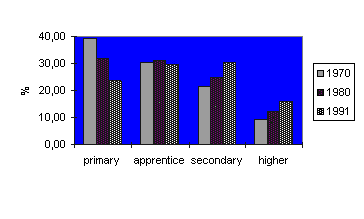
Fig. 1 - The educational structure of the population of Prague in 1970, 1980 a 1991.
Source: Population census 1970, 1980 a 1991.
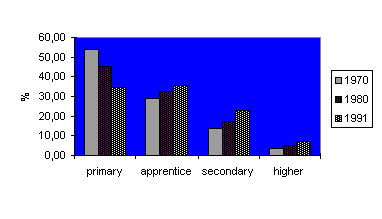
Fig. 2 - The educational structure of the population of the Czech Republic in 1970, 1980 a 1991.
Source: Population census 1970, 1980 a 1991.
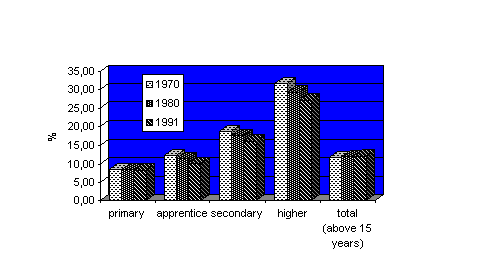
Fig. 3 - Percentage of population of Prague in educational categories in the Czech Republic.
Source: Population censuses 1970, 1980 and 1991.
For more detailed analyse we used Prague's cadastral units and we focused on the comparison
of the educational structure (percentage of ss+hs) in the period 1980 - 1991. When we look
at the cartograms from the beginning and the end of analysed period (Fig. 4 and 5) we can
find out significant changes of the educational structure in particular parts of the city.
The lowest percentage of ss+hs was recorded in villages located in peripheral belt. Five of
them had only 10 % or less of people with ss+hs education. In 1991 there were 8 cadastral
units with the percentage of ss+hs under 20 %. In both census years the highest percentage
of ss+hs had cadastral units of north-western part of Prague with a location nearby centre
and an areas with so called "good addresses". Among these areas belong quarters with good
quality of living, often with the high proportion of apartments in family houses, i.e.
Střešovice, Dejvice, Hodkovičky, Hradčany, Podolí etc. In 1991 the central area extended
this group, too.
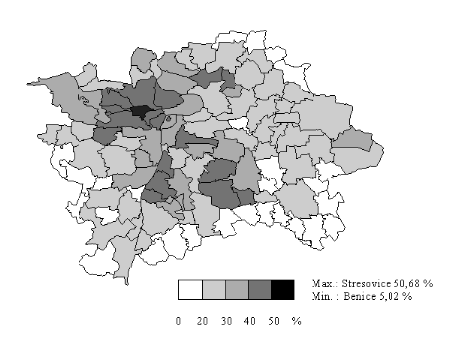
Figure 4 - Proportion of the population with secondary and higher education in 1980
Source: Population census 1980
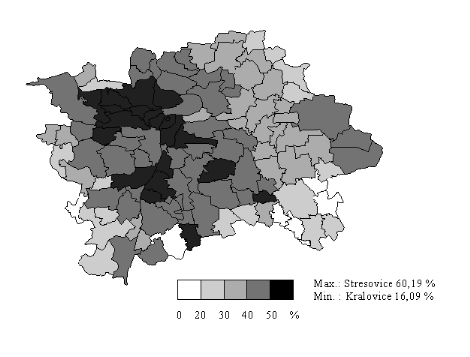
Figure 5 - Proportion of the population with secondary and higher education in 1991
Source: Population census 1991
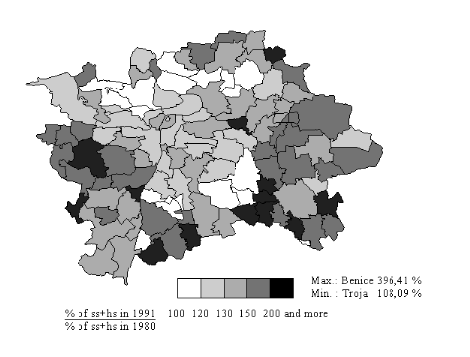
Figure 6 - The change in proportion of the population with secondary and higher education in the period 1980 - 1991 (1980 = 100 %)
Source: Population census 1980 and 1991
The changes of the educational level were measured by means of two different indicators.
Firstly we counted a difference between the percentage in 1980 and 1991. Secondly we relate
the proportion of ss+hs in 1980 and 1991, so that percentage ss+hs in 1980 = 100 %
(see Fig. 6). Values from the beginning and the end of variation series are mentioned below:
| Cadastral unit | Changes in % of 1980 | Cadastral unit | Differences between 1991 and 1980 |
| 1. Benice | 396,4 | 1. Písnice | 34,10 |
| 2. Malá Chuchle | 299,5 | 2. Petrovice | 31,39 |
| 3. Písnice | 290,0 | 3. Malá Chuchle | 29,14 |
| 4. Křeslice | 258,7 | 4. Stodůlky | 25,64 |
| 5. Miškovice | 258,0 | 5. H. Měcholupy | 25,53 |
| . |
| 106. Chodov | 113,1 | 106. Bohnice | 4,46 |
| 107. Bohnice | 112,2 | 107. Nebušice | 3,78 |
| 108. Háje | 111,0 | 108. Troja | 3,22 |
| 109. Lipany | 108,4 | 109. Hájek | 2,90 |
| 110. Troja | 108,1 | 110. Lipany | 1,18 |
The percentage of ss+hs has not decreased in any cadastral unit in the selected period. When
we neglect changes in the smallest units, we can see the most significant changes in the areas
with the construction of new houses. Outstanding changes in the educational level of
population are occurred in the areas with new housing estates where in-migrated a large
number of young people. As we mentioned above the educational structure of Prague 5 went
through considerable changes those were connected especially with the construction of huge
housing estates, i.e. Barrandov, South-west Town and Řepy. On the right bank of the Vltava
River the educational level has increased in area of Modřany - Písnice and Petrovice - Horní
Měcholupy - Horní Počernice.
In case of areas with the smallest changes of the educational structure we can recognise two
different types. Firstly, there are the housing estates of so called "second generation"
(constructed in late 70´s), i.e. North Town, South Town and Lhotka. These areas have very
stable social structure of population. Secondly, another areas with only small changes in
the proportion of ss+hs represent these ones with the highest educational level recorded in
1980.
The last step of our study was the verification of the results by selected urban districts
of Prague. The urban district of centre, traditionally social strong area in Prague 6
(Hradčany, Střešovice and Dejvice) and Prague 4 as a segment of the city with the representative
proportion of particular types of urban districts were entered the evaluation. Even on this
level it was verified, that considerable changes take place in outer city and periphery with
very low recorded level of education at the beginning of the period and also in urban districts
with new construction (housing estates). Strong relation between the quality of living and
the level of education is significant. The population living in family houses is more stable
than others and in these areas there are no considerable changes of the social structure of
population.
Summary:
The main feature in the development of the educational structure in Prague is a gradual rise
of the educational level of population. Differences in the educational level between males and
females are nowadays smaller than in the past. The trend toward a certain homogeneity is also
observable within the spatial structure of the city and in the relation capital city - republic
(decreasing proportion of Prague in total number of people with secondary or higher education).
In the areas with high educational level the proportion of the highest categories of education
has changed only slightly, on the contrary in the outer city, periphery and other parts with a
lower proportion of ss+hs considerable changes in improving of the educational structure are
obvious. Among the most stabilised parts of the city, where only small changes in social
structure were occurred, belong so called "housing estates of second generation" (i.e. South
Town). Most considerable changes are seen in outer city and in newly settled areas. Significant
is also improvement of the educational structure of the Prague's centre.
References:
OUŘEDNÍČEK, M. (1992): Vzdělanostní struktura Prahy. [The Educational Structure of Prague]. BA thesis. Department of Social Geography and Regional Development. Charles University of Prague. 35 pp.
OUŘEDNÍČEK, M. (1995): Úroveň vzdělání obyvatel Prahy 1980 - 1991. [The Educational Level of Prague's Population 1980 - 1991]. (manuscript).18 pp.
WAHLA, A. (1988): Geografie vzdělání obyvatelstva. [The Geography of the Education of Population]. SPN. Prague. 189 pp.
Sčítání lidu, domů a bytů 1970, 1980 a 1991. [Population census 1970, 1980 and 1991]. Czech Statistical Office (ČSÚ). Prague.
Tables 117 OB 2. Special results for urban districts prepared by Czech Statistical Office for Chief Architect's Office. Population censuses 1980 and 1991.
Martin Ouředníček





